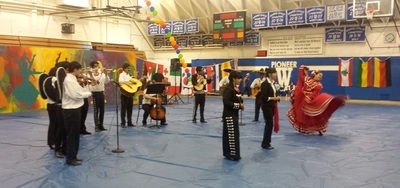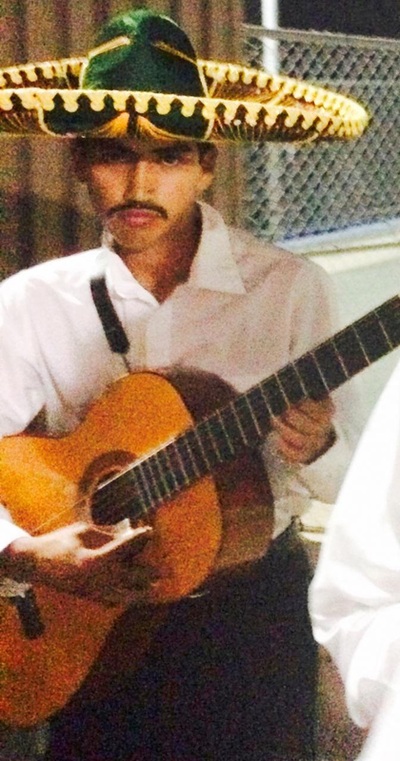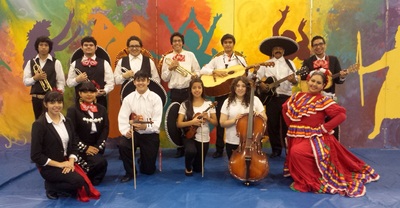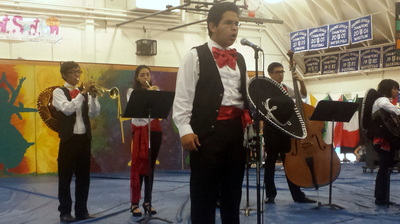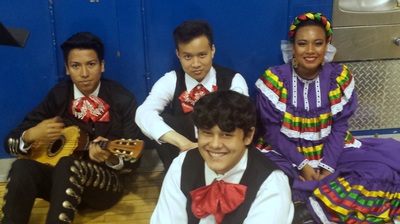Mariachi de los Pioneros
If you sing, play guitar, violin, viola, or trumpet and would like to be a part of Mariachi de los Pioneros please contact Ms. Hench. We perform for school and community events and meet on a voluntary basis. It is lots of fun and new members are always welcome!
|
(Click link to hear "Guadalajara")
|
Please click on photos for full image
Origins of Mariachi Music:
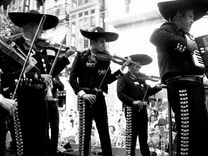
- According to Mexconnect.com, the Mariachis are known to have originated in Jalisco, Mexico, but their exact birthplace is up for debate. According to Maricahi.org, a common theory is that Mariachi is specifically from the town of Cocula. There is also much debate over the origin of the name Mariachi. According to Mexconnect.com, the word Mariachi could be a reference to the French word for wedding or marriage, where Mariachi music is commonly heard; a reference to the indigenous trees Mariachi instruments are made from; or even to the festival of the Virgin Mary H., pronounced mah-ree-ah AH-chay.
- According to Mariachi.org, the original music of the Mariachi band was the "son." The son was a mixture of African, Mexican and Spanish tradition, and rooted in Mexican storytelling and tales of brave Mexican warriors. The site also explains that the rhythmic pattern of the son is syncopated, alternating between 3/4 and 6/8 time Sones from Jalisco became known as "son jalisciense." The most famous son jalisciense is "La Negra." Sones from the Gulf port of Veracruz are known as "son jarocho" or "son veracruzano," and you may recognize "La Bamba" as the most famous of this genre. Sones from northeastern Mexico are known as "son huasteco" or "son huapango," and the most famous of these is "La Malaguena." Despite these regional classifications, there are some sones that are popular throughout all of Mexico, proving that Mariachi music is rooted in a common ancestor.
Instrumentation:- Early Mariachi bands used a variety of instruments including violins, guitars and harps, brass horns, and woodwinds, which were brought to Mexico by Spanish explorers and settlers. In time, the accordion found a place in Mariachi music, and Mexicans designed their own guitar-like instruments. As jazz music became popular, the horn became integral, A modern Mariachi band consists of as many as six to eight violins, two trumpets, a guitar, a vihuela, guitarrón and a Mexican folk harp.
Popularity- At first, the Mariachis dressed in traditional labor clothing and sought work at local haciendas. While the Mariachi bands were a common local tradition for weddings and festivals, they did not receive popular cultural notoriety until Gaspar Vargas founded the Mariachi Vargas de Tecalitlán in 1898. According to ElMariachi.com, Vargas's son, Silvestre Vargas, took over leadership of the group in 1928. When populist President Lázaro Cárdenas was looking for a way to unify the people of Mexico as part of his campaign in 1936, he enlisted the Mariachi Vargas de Tecalitlán to play the music of his campaign all across Mexico. Mariachi quickly became a symbol of Mexican nationalism.
- As Mariachi music gained popularity, Mariachi bands adopted elaborate costumes and emerged onto the popular music scene around the world. Relying on commercial success and the adoption television in the 1950s, the Mariachis became the symbol of Mexican musical culture. In Mexico, Mariachi bands still play at weddings and festivals, and tourists can pay Mariachi bands in town squares to play tunes.
- According to Mariachi.org, the original music of the Mariachi band was the "son." The son was a mixture of African, Mexican and Spanish tradition, and rooted in Mexican storytelling and tales of brave Mexican warriors. The site also explains that the rhythmic pattern of the son is syncopated, alternating between 3/4 and 6/8 time Sones from Jalisco became known as "son jalisciense." The most famous son jalisciense is "La Negra." Sones from the Gulf port of Veracruz are known as "son jarocho" or "son veracruzano," and you may recognize "La Bamba" as the most famous of this genre. Sones from northeastern Mexico are known as "son huasteco" or "son huapango," and the most famous of these is "La Malaguena." Despite these regional classifications, there are some sones that are popular throughout all of Mexico, proving that Mariachi music is rooted in a common ancestor.
How to Play the Trumpet Like a Mariachi

Playing like a mariachi is a matter of style. The classical valve trumpet is a versatile instrument whose voice is an essential part of many musical ensembles outside the world of orchestral music. One of these is the Mexican mariachi band, a small popular chamber ensemble whose sound is often dominated and characterized by the sound of the mariachi trumpet. While any proficient trumpet player can play the notes of mariachi music, playing in mariachi style is different in character and execution from playing in classical or jazz styles.
Instructions
Instructions
- Use a forceful articulation at all times. Mariachi trumpets typically play with a sharp, strong articulation, produced by pressing the tongue firmly against the lips and back of the teeth (where you normally articulate), then removing it as quickly as possible to create a short, strong burst of air.
- Play punchy, separated notes when playing upbeat music. Use a "dut" syllable for articulating short notes to make them more percussive and make them more audible within the texture of the band.
- Develop a strong double-tonguing ability. Much mariachi music includes fast passages that are traditionally played with a very crisp double tongue.
- Exaggerate dynamic phrasing. Make more out of the contrast between louds and softs in phrases than you would normally do for classical or jazz phrasing, especially in passages where the trumpet is meant to emerge from the texture. In general, keep in mind that mariachi trumpet playing tends toward the loud.
- Play with tempos when playing slow, rubato solo passages. Trumpet solos in mariachi music commonly call for flashy, stop-time trumpet solos. If you play one of these, be generous with the rubato, especially when it comes to taking time to pause between statements within the phrase.
- Employ proper use of vibrato. Use a wide but fast vibrato; this is perhaps the most distinctive aspect of the mariachi trumpet sound.
Tips and Warnings:
The best way to know what you're striving for in creating an authentic mariachi trumpet sound is to listen to real mariachi players. While you're trying out this style in the practice room, be sure you also spend time listening to recordings.- Use a forceful articulation at all times. Mariachi trumpets typically play with a sharp, strong articulation, produced by pressing the tongue firmly against the lips and back of the teeth (where you normally articulate), then removing it as quickly as possible to create a short, strong burst of air.



